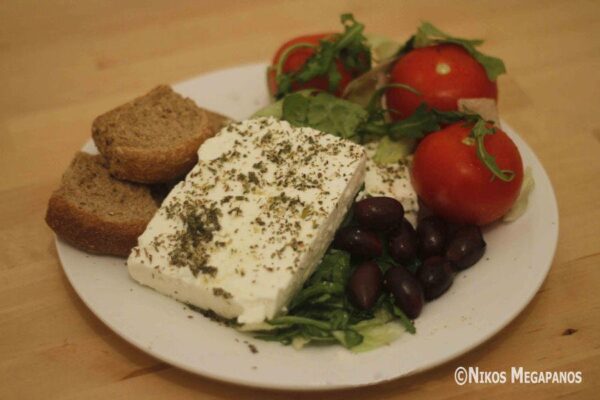Feta: The White Soul of Greece
Few foods tell the story of a nation as vividly as feta cheese. Tangy, crumbly, and kissed by the salt of the Aegean, feta is not only Greece’s most famous cheese — it’s the heart of its culinary identity. Representing nearly 70% of all cheese consumed in Greece, feta is a cornerstone of Greek life, served at every meal and celebrated across generations.
🏺 A Cheese as Old as Myth
The history of feta stretches deep into Greek mythology. Homer himself described cheese made from sheep’s milk, stored in brine to preserve its freshness — a method that endures today. From the mountain pastures of Macedonia to the islands of Lesbos, feta has nourished Greeks for thousands of years.
Cheese in Greece has always been more than food; it’s an expression of philotimo — the love of life, generosity, and community. A simple piece of feta, drizzled with olive oil and sprinkled with oregano, still carries that timeless spirit.
🐑 Born from the Land
Authentic feta is made exclusively from sheep’s milk, or from a blend that includes up to 30% goat’s milk — always sourced from animals grazing freely on the herb-covered hills and valleys of Greece. These herds feed on wild thyme, sage, and oregano, infusing the milk with the distinctive aromas of the Mediterranean landscape.
To produce traditional feta, 30% goat’s milk is mixed with sheep’s milk from herds raised in regions granted the Protected Designation of Origin (PDO) status. According to EU legislation, only cheeses made in Macedonia, Thrace, Thessaly, Central Greece, the Peloponnese, and Lesbos can legally be called feta. Similar cheeses made elsewhere must be labeled “white cheese.”
Once produced, the curds are pressed, salted, and aged in brine for at least two months. This slow maturation process develops feta’s characteristic creamy-yet-crumbly texture and tangy flavor — a taste that varies subtly from region to region.
🌿 Terroir and Tradition
The firmness, texture, and flavor of feta differ according to geography. In the north, it may be firmer and more savory; in the islands, creamier and milder. The local environment, animal breeds, and even bacterial cultures used during fermentation all contribute to its unique sensory profile.
This regional diversity gives Greek feta its remarkable depth — a reflection of the country’s varied landscapes and centuries-old cheesemaking traditions.
🧂 The Art of Simplicity
In Greece, feta isn’t just an ingredient — it’s part of daily life. It appears at nearly every meal, in dishes that range from rustic to refined:
-
Greek salad (Horiatiki) – feta crowns tomatoes, cucumbers, and olives, glistening with olive oil.
-
Spanakopita and Tiropita – the beloved phyllo pies filled with spinach or cheese, where feta’s saltiness balances the buttery layers.
-
Simple meze – a slice of feta drizzled with olive oil, garnished with olives and aromatic herbs like oregano.
-
Cooked or grilled – feta softens deliciously in the oven or pan, served with peppers, tomatoes, or honey.
-
In sandwiches or omelets – adding richness and depth to even the simplest meal.
Each preparation celebrates feta’s versatility — a cheese that can be rustic or elegant, comforting or bold.
🌍 Protected by the European Union
Since 2002, feta has held Protected Designation of Origin (PDO) status within the European Union. This legislation safeguards both the cheese’s authenticity and the heritage of its producers. Only feta made in the designated Greek regions, from local milk and by traditional methods, can carry the name.
Every slice of authentic Greek feta tells a story — of soil, sea, and shepherds. Beyond Greece, countless imitations try to capture its essence, but none can replicate the genuine character that comes from its birthplace.
🍷 A Cultural Companion
Pair feta with a crisp Assyrtiko from Santorini or a floral Moschofilero from the Peloponnese, and it transforms from cheese to cultural experience. The salty tang of the feta, the minerality of the wine, and the scent of Mediterranean herbs create a harmony that reflects the Greek way of life — simple, honest, and joyful.
Whether served at a seaside taverna or a village kitchen table, feta connects people to the rhythm of Greece itself: generous, sun-drenched, and timeless.
✨ The Essence of Greek Life
Feta is more than just a cheese — it’s a living link to Greece’s land, traditions, and people. From shepherds tending flocks in the hills of Thessaly to cooks layering spanakopita in bustling Athenian bakeries, feta embodies the spirit of continuity.
A crumble of feta, and you’re there — under the olive trees, a sea breeze on your face, the sound of cicadas rising in the distance. It’s the taste of Greece: pure, ancient, and eternal.




